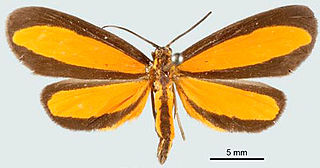
Erbessa mimica is a moth of the family Notodontidae first described by Hering in 1925. It is found in Bolivia.

Josia is a genus of moths of the family Notodontidae erected by Jacob Hübner in 1819.

Josia oribia is a moth of the family Notodontidae first described by Herbert Druce in 1885. It is found in the eastern Andean foothills of Peru and Bolivia.

Scea is a genus of moths of the family Notodontidae.
Anticoreura is a monotypic moth genus of the family Notodontidae described by Prout in 1918. Its one species, Anticoreura salmoni, first described by Herbert Druce in 1885, is found in Colombia.

Erbessa is a genus of moths of the family Notodontidae. It consists of the following species:
Tithraustes is a genus of moths of the family Notodontidae described by Herbert Druce in 1885.

Disphragis is a genus of moths of the family Notodontidae erected by Jacob Hübner in 1820. The genus is confined to the New World and it contains about 137 species.
Erbessa alea is a moth of the family Notodontidae first described by Herbert Druce in 1890. It is found in Ecuador.
Erbessa avara is a moth of the family Notodontidae first described by Herbert Druce in 1899. It is found in Ecuador.
Erbessa capena is a moth of the family Notodontidae first described by Herbert Druce in 1885. It is found in Colombia, Ecuador, Peru, Brazil and French Guiana.
Erbessa cassandra is a moth of the family Notodontidae first described by Herbert Druce in 1885. It is found in Colombia, Ecuador and Peru.
Erbessa citrina is a moth of the family Notodontidae first described by Herbert Druce in 1898. It is found in Peru, Venezuela, French Guiana and Brazil.
Erbessa graba is a moth of the family Notodontidae first described by Herbert Druce in 1899. It is found in Brazil, Peru, Colombia and Ecuador.
Erbessa inaria is a moth of the family Notodontidae first described by Herbert Druce in 1885. It is found in Ecuador and Peru.
Erbessa labana is a moth of the family Notodontidae first described by Herbert Druce in 1895. It is found in Venezuela, Ecuador, Peru and Brazil.
Erbessa lamasi is a moth of the family Notodontidae first described by James S. Miller in 2008. It is found in south-eastern Peru.
Erbessa mitys is a moth of the family Notodontidae first described by Herbert Druce in 1899. It is found in Brazil, French Guiana and Venezuela.
Erbessa ovia is a moth of the family Notodontidae first described by Herbert Druce in 1893. It is found in Ecuador, Peru and Brazil.
Erbessa pales is a moth of the family Notodontidae first described by Herbert Druce in 1893. It is found in Ecuador, Brazil, Peru and Bolivia.





